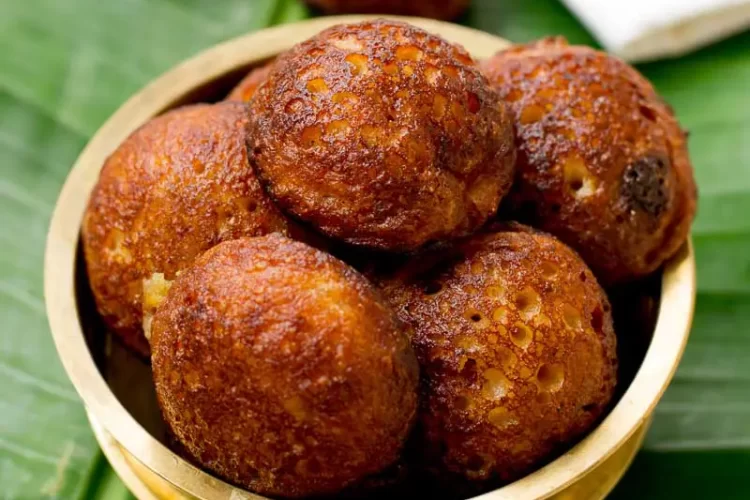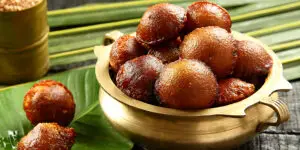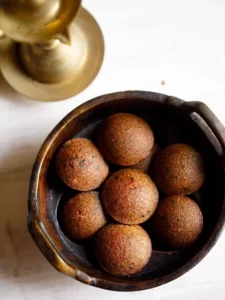Unniyappam is a popular sweet snack or dessert from Kerala, a state in South India. It is typically made during festivals like Onam or as an offering to deities in temples. Unniyappam is made using a special appe or paniyaram pan with small, round cavities.
The batter is prepared with a combination of rice flour, mashed bananas, jaggery (a type of unrefined sugar), and coconut, and flavored with cardamom. The batter is then deep-fried in ghee or oil until golden brown, resulting in small, round, and crispy dumplings.
The shape of unniyappam resembles a small, round, puffed ball with a soft and spongy interior. It is commonly enjoyed as a snack or served as an offering in temples during religious festivals like Onam and Vishu.
Unniyappam is cherished for its rich and sweet flavor, combining the natural sweetness of ripe bananas and jaggery with the aromatic notes of cardamom. The presence of coconut adds a delightful texture and imparts a mild tropical taste. It is a beloved treat among locals and visitors alike, and its popularity has spread beyond Kerala to other parts of India and even internationally.
In addition to its delicious taste, unniyappam also holds cultural significance in Kerala. It is often associated with festive occasions and is prepared during special celebrations and family gatherings. The preparation and sharing of unniyappam are considered a symbol of hospitality and togetherness, fostering a sense of unity and joy among people.
Overall, unniyappam is a delightful South Indian sweet snack that showcases the unique flavors and culinary traditions of Kerala. Whether enjoyed as a personal treat or shared with loved ones, it continues to be a favorite indulgence for those who appreciate the rich and diverse cuisine of the region.
Also, read more recipes:
Ingredients:
- 1 cup rice flour
- 1/2 cup jaggery (unrefined cane sugar), grated or chopped
- 2 ripe bananas, mashed
- 1/4 cup grated coconut
- 1/2 teaspoon cardamom powder
- A pinch of baking soda
- Ghee or oil for frying
Instructions:
- In a mixing bowl, combine the rice flour, grated jaggery, mashed bananas, grated coconut, cardamom powder, and baking soda. Mix well to form a thick batter. If the batter appears too thick, you can add a little water to adjust the consistency.
- Allow the batter to rest for about 2-3 hours to allow it to ferment. This step is optional, but it helps enhance the flavor and texture of the recipe.
- Heat the appachatti or appe pan on medium heat and add a small amount of ghee or oil into each cavity.
- Once the ghee or oil is hot, spoon small portions of the batter into each cavity of the appachatti, filling them about 3/4th full.
- Allow it to cook on medium-low heat for a few minutes until the bottom side turns golden brown.
- Using a skewer or a fork, carefully flip the unniyappam over to cook the other side. Add more ghee or oil if needed.
- Cook until both sides are evenly golden brown and are cooked through.
- Remove the cooked it from the appachatti and place them on a paper towel to absorb any excess oil.
- Repeat the process with the remaining batter until all the unniyappam is cooked.
- Allow it to cool slightly before serving.
- Unniyappam is typically enjoyed warm. It can be served as a snack or dessert. You can store any leftovers in an airtight container and consume them within a day or two for the best taste and texture.
Serving suggestions
- As is: Unniyappam can be enjoyed on its own, serving as a delicious sweet snack or dessert.
- With tea or coffee: Pair the dish with a hot cup of tea or coffee. The combination of the sweet dumplings and the warm beverage creates a delightful contrast of flavors.
- With coconut chutney: Serve unniyappam with a side of coconut chutney. The creamy and slightly tangy chutney complements the sweetness, adding a refreshing element to each bite.
- With fruit compote: Create a fruity accompaniment by making a simple fruit compote using fruits like mango, pineapple, or banana.
- With ice cream: For a decadent treat, serve warm with a scoop of vanilla ice cream. The combination of warm dumplings and cold ice cream provides a delightful contrast in temperatures and textures.
Tips and Variations
- Use ripe bananas: Make sure to use ripe bananas as they add natural sweetness and moisture to the batter, enhancing the flavor and texture of the unniyappam.
- Fermentation: Allowing the batter to ferment for a few hours can improve the taste and texture of the unniyappam. However, if you’re short on time, you can skip the fermentation step and proceed with frying the batter immediately.
- Adjust consistency: The batter should be thick enough to hold its shape when dropped into the appachatti, but not too thick that it becomes difficult to work with. If the batter is too thick, add a little water to achieve a pourable consistency.
- Proper heat control: Maintain medium to medium-low heat while frying the unniyappam to ensure they cook evenly and don’t get burnt. Adjust the heat if necessary to prevent overcooking or undercooking.
- Appachatti or appe pan: If you don’t have an appachatti or appe pan, you can use a regular frying pan. Drop small portions of the batter into the hot oil and shape them into small round dumplings using the back of a spoon.
Variations:
- Nutty twist: Add a handful of chopped nuts like cashews or almonds to the batter for some added crunch and flavor.
- Sesame seeds: Sprinkle some sesame seeds on top of the batter just before frying to give them a nutty and aromatic touch.
- Raisins or chopped dates: For an extra burst of sweetness, you can add a few raisins or chopped dates to the batter before frying. They add a delightful texture and taste.
- Jackfruit: If available, you can add a few pieces of mashed ripe jackfruit to the batter, giving the unniyappam a unique tropical flavor.
- Jaggery syrup: Instead of incorporating grated jaggery into the batter, you can prepare a thick jaggery syrup by melting the jaggery in a little water, straining it, and then mixing it into the batter.
FAQs
- Can I make unniyappam without fermenting the batter?
Yes. While fermentation enhances the flavor and texture, it is not mandatory. You can skip the fermentation step and proceed with frying the batter immediately.
- Can I use wheat flour instead of rice flour?
Traditionally, rice flour is used to make unniyappam. However, you can experiment with using wheat flour or a combination of wheat and rice flour. Keep in mind that the texture and taste may vary slightly compared to the traditional version.
- Can I use white sugar instead of jaggery?
Jaggery is preferred for its distinct flavor and natural sweetness. However, if jaggery is not available, you can substitute it with an equal amount of brown sugar or white sugar. The taste will be slightly different, but it will still be enjoyable.
- How long can I store unniyappam?
Unniyappam is best consumed fresh on the day of preparation. However, you can store any leftovers in an airtight container at room temperature for up to 1-2 days. Keep in mind that the texture may become slightly denser with time.
- Can I make a larger batch?
Yes, you can scale up the recipe to make a larger batch. Just ensure that you maintain the proportions of the ingredients and adjust the cooking time and heat accordingly.
Nutrition
| Calories | 500 kcal |
| Fat | 15 g |
| Carbohydrates | 60 g |
| Sodium | 284 mg |
| Potassium | 505mg |
| Protein | 10 g |
| Vitamin A | 959 IU |
| Calcium | 343 mg |
| Vitamin C | 1 mg |
| Iron | 1mg |
Also, read the following:
- Chicken Momos Recipe (step by step)
- Paneer do pyaza recipe
- how to make paneer butter masala
- Palak Paneer Recipe
- Paneer Dum Biryani Recipe





